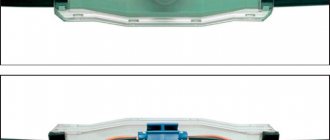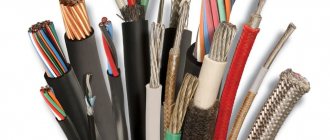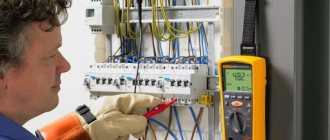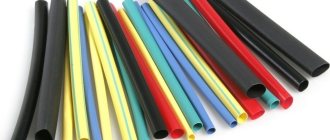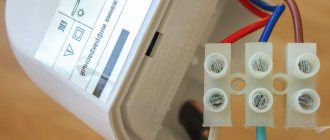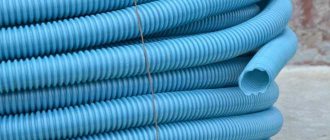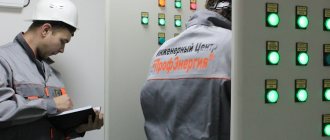The main distinguishing feature of any cable switching in household electrical networks is that they must be carried out in one housing. It should be mentioned that the housing must be absolutely sealed and reliably protect the wires inside from the negative effects of external factors. You also need to know that the insulation of a cable buried in the ground is permanently exposed to significant mechanical stress, groundwater, and soil acids.
The length of cable commutation can range from several meters to hundreds of kilometers. However, manufacturers of such products do not have the ability to produce such a long cable. The fact is that its length is limited by the size of the cable reel, as well as by the possibilities of transportation. That is why, when laying such communications, the problem of creating the correct connection of two fragments of the cable fabric, and then connecting it to the necessary equipment, often arises.
For these purposes, the following elements are used:
- connecting adapter for the cable and its individual fragments;
- end coupling, it is used to connect the ends of power lines to distribution buses of electrical equipment.
The first type of connectors are used to connect cables to each other, after which they are left in the trench and buried. The latter type of connection is reliably protected by a durable shield housing, which is locked with a lock, preventing the entry of third parties.
Coupling
Return to content
Technical requirements for couplings
If you carefully examine the cable connected by means of a coupling, you will notice that this part sequentially connects individual fragments of the cable fabric to each other. Because of this, the coupling for the power cable must also transmit electricity with minimal losses.
It is very important that the area of contact between the connecting element and the cable conductors corresponds to the size of the conductors, and ideally even be a little larger. We should not forget about the crimping force. It must not only guarantee reliable contact from a mechanical point of view, but also the normal movement of electric current with minimal resistance.
For the above reasons, the cores of any cable are secured using:
- tips, which are subsequently fixed with fasteners;
- special sleeves with additional fasteners and crimping.
End coupling
The insulating layer of the connecting element must:
- easy to transfer phase-to-phase voltage;
- have sufficient resistance to mechanical stress to protect the housing from breakdowns;
- resist the harmful effects of soil and groundwater for quite a long time.
Return to content
Types of wire and cable connections
The structure of the electrical coupling is designed based on such parameters as the cross-sectional features of the cables, the number of cores, the voltage rating used and the insulating material of the wires. The difficulty of docking is determined by the degree of demands on reliability and the quality of the connecting unit.
Simple twist
This method of connecting cables is used in structures that are not particularly demanding on power lines. To make the connection more reliable, twist soldering is performed. The joint areas are covered with tubes - most often rubber, but they can also be made of another dielectric.
Individual and group clamps
Sleeve-type terminals are used to connect the ends of coaxial wires. For them, direct contact and RF protection are important.
Crimping sleeves
Such products are made from flexible materials that conduct electricity well: aluminum and copper. Weaves of several strands are inserted into the crimp sleeve from both sides and then the tube is processed with pliers.
Cable sleeves
These products help protect connections from water, chemicals and other harmful environmental factors. In the industrial production of cable couplings, state standards are strictly observed; the manufacturer is responsible for the safety and quality of the joints.
Connecting CM
The coupling for connecting wires is used when installing contact nodes for branching communications. To choose the right product, you need to consider the type of line.
Important! Connectors are commercially available that can withstand extreme temperatures up to 500 degrees above and below zero. This way you can choose a coupling that is suitable for any operating conditions.
Installation of the coupling
Types of cable connectors
To make the right choice of connecting element, you need to look at these technical indicators of the product:
- number of wires in the cable;
- cross-sectional area, as well as the material used to make the veins;
- maximum network voltage;
- type of interphase insulation;
- protective equipment that increases the resistance of the cable from various types of influences.
Based on the value of the maximum voltage in the electrical network, connecting elements are manufactured for use in:
- high-voltage switching;
- electrical networks with voltages up to 1000 V.
Four-wire coupling
As a rule, the maximum number of wires connected by a coupling does not exceed four, however, in some cases there are connections with a large number of wires on one coupling.
To correctly install the coupling on the cable, you must cut the ends correctly, and then very carefully remove all the insulation. Then it will require carefully preparing all surfaces in turn for installation of the connecting element. From each end, it is necessary to completely cut off the insulation to half the length of the connecting element, into which both ends of the wire must then be inserted and firmly clamped with fasteners.
The same connection method is used to connect the wires to the terminal. In this case, it is necessary to dismantle the insulating layer; the entire length of the connecting part must be removed.
For wires with a large number of copper strands that are connected together, it is better to use tips made of materials that are easily deformed. These tips are compressed with a special tool at the last stage of connection. The result should be a mechanically strong one, as well as good electrical contact. For high-quality crimping, a force of several tons must be applied.
The design of the connecting elements used directly depends on the type of interphase insulation.
Interfacial insulation of coupling
Return to content
Couplings for armored cable
Armored cable is used very often when organizing power supply to equipment, since it is not afraid of mechanical shocks during installation and operation. For this type of cable products, a special type of cable couplings is used, which are marked with a capital or small letter “B”; some manufacturers may not mark their products in a different way. The cable coupling for armored cable faces the task of not only high-quality and reliable connection of cores with maximum sealing, but also restoration of impact resistance and mechanical protection of the area where the coupling is installed.
At the same time, cable couplings for armored power cables can be designed for standard 3, 4, or 5 cores, but also designed for installation on a single-core cable.
In order to ensure and restore resistance to mechanical damage, cable couplings for splicing, branching or terminating armored cables are equipped with metal “stockings” and grounding conductors. Here are several brands of products for armored cable 3 PKV(N) Tpb1, 3PSTb1, 4STp1 (universal).
Couplings
A coupling called 1Stp-3x150-240S. This is a coupling for paper-insulated cable. Below is a transcript of its name:
- “1” – for electrical networks with a maximum voltage of up to 1000 V;
- “C” – connecting part;
- “tp” - thermoplasticity is present;
- “3” — number of wires;
- “150-240” - minimum and maximum cross-sectional area in millimeters;
- “C” - the presence of additional fasteners.
Connecting elements with PVC wiring have another letter “P” in their names.
Couplings
Also, after indicating “tp”, that is, a thermoplastic insulating layer, the features of the product can be indicated:
- “R” means repair;
- "B" - armored;
- “O” is a cable with one core.
Return to content
Control cable couplings
A control cable is often a multi-core cable product, each of the cores of which has its own insulation; its task is not to supply power supply voltage to electrical equipment, but to implement protection, signaling, and control circuits. This type of product also includes communication cables. In this case, lead couplings are used for communication cables, for example MS-20, which restores the protective sheath of the cable along with a single piece. All control cables are laid both indoors and outdoors and therefore very often require protection from mechanical damage. When marking cable couplings for a control cable, there are many, here is an example of the most common set - PSTk (connecting) or KKT (terminal), they are used for control cables with a number of cores from 4 to 37, the cross-section of which does not exceed 10 mm?.
Do you need cable couplings? Send your request and we will complete your order. We will select brands and give the best prices!
Send a request
End couplings
For these elements, which are used on paper-insulated cables, there is a name - 1KV(N)tp-3x150-240N. There are many additional characters in the name, each of which carries some information:
- “K” - end;
- “B” and “H” - indicate the type of installation (inside or outside);
- The “H” at the end indicates the presence of additional fasteners.
To designate connecting elements with an insulating layer of cross-linked polyethylene and polyvinyl chloride, the same rules apply, only the letter “K” is added.
By clicking on the link, you will learn how to lay a cable underground. You might also be interested in how to secure a cable duct. In this article you will find information about electrical wiring diagrams.
Based on the design of the outer protective layer, the best cable is a product with an armored layer. Couplings that are used to connect such cables are designated by the letter “B”
This protective layer must have the same potential relative to the wire and ground. To ensure this possibility, all cable ends are connected to metal fragments of connecting elements using a special outlet.
To perform cable switching in networks with voltages from 6 to 10 thousand volts, the following couplings are used:
- lead;
- epoxy.
Lead coupling
Connecting elements made of epoxy resin are the most resistant to harmful factors. They can also be used as stop components in the insulating layer of cables with paper as the insulating material. To install them, it is necessary to make a metal case from two fragments, in which to carry out installation work. This coupling is supplied with the following:
- chamber with filler and resin;
- chamber with hardener;
- Additional materials.
This type of connecting parts is covered with a layer of fire-resistant material and is reliably protected from various types of influences using a metal case, the thickness of which is 0.5 centimeters.
Lead connectors are used to connect cables with aluminum or lead winding. They are made in the form of tubes with a diameter of 6 to 11 centimeters, and the length ranges from 45 to 65 centimeters.
When the installation of the coupling on the cable using the usual method is completed, the area on which there is no insulating layer left must be treated with heated MP-1 cable compound in order to get rid of water. Then the layer of “original” insulation should be restored. The lead connecting elements are also reliably protected by a metal casing.
Epoxy coupling
Stop couplings are included in the group of couplings. They are used when it is necessary to protect the insulating layer from melting due to temperature changes.
Return to content
Rules for selecting cable sleeves
When choosing a cable sleeve that would meet the installation conditions, as well as the purpose of the circuits for which it is installed, you need to know the basic criteria for choosing this product:
- Rated voltage of the line in which the coupling is installed. All cable couplings are divided into two categories: high-voltage (from 1 kV) and low-voltage (up to 1 kV). The voltage value is a parameter that is determined from the type of electrical installation;
- The number of cores in the cable and their cross-section. The brand of the cable coupling contains encrypted information about the cross-sectional range of the cable cores for which it can be used. For example, the Stp 10/4*25-50 set is intended for 10 kV networks, and the cable cross-section is from 25 to 50 mm?;
- Type of insulation. The insulating material that is used as the main one must exclude not only breakdowns between phases, but also on the armored layer, which is grounded. Also, the selected coupling and its main insulating material must withstand long-term use and exposure to external factors. One of the most popular today is heat-shrinkable material that changes its shape and size when exposed to temperature. It has high dielectric properties and to install such a coupling you only need a torch or blowtorch;
- Cables that require a coupling can be armored steel strips, wire, or lead sheathed. In sets of cable couplings for armored cables there must be special materials connecting the armor;
- The type of coupling must correspond to the purpose; the end coupling cannot become a connecting coupling and vice versa.
Before purchasing a cable coupling, you need to look at its configuration; usually they are all equipped with lugs or self-breaking sleeves, but if they are not included in the kit, you will have to purchase such products separately.
Couplings with insulation made of heat-shrinkable tubing
Installation of heat-shrinkable couplings on cables is very simple, since the presence of plastic elements greatly simplifies the entire process of connecting wires of cable fragments. The time required for installation in this case is approximately two times less than in the case of other connecting elements.
When the temperature is raised to 150 degrees using a gas burner or a hair dryer, polymer materials contract strongly and grasp the elements being pressed quite well, covering them 100%. Air masses from all cavities are released during this process through hot polymer material. As the heated material cools, it firmly adheres to the fragments of the power line and reliably envelops them. The service life of such switching can reach 25 years.
Heat-shrinkable sleeve
Return to content
Description and scope of application of heat-shrinkable sleeves
The cables are connected to each other and to other elements of power supply and communication systems using special couplings. There are a large number of similar products, for example, based on the material they are made of, they are divided into cast iron, brass, lead, epoxy and heat-shrinkable. The latter option has become especially widespread recently. This is explained by a combination of several obvious advantages, the main of which is the combination of ease of installation with a reliable and durable connection. A heat-shrinkable cable sleeve is a set of materials, the use of which ensures the integrity of the cable - electrical, structural and mechanical. The main parameters of the product are:
- design features;
- voltage;
- number of cores;
- type of insulation.
Heat-shrinkable cable sleeves are the latest and most modern generation of such products. The principle of their operation is based on the use of the properties of polymers with so-called shape memory. Such materials are capable of stretching when heated, maintaining their newly acquired dimensions until the next heating. In this state, they are delivered to the place of practical use, after which they are put on the elements of the cable system that need to be connected. This is followed by reheating to a temperature of 120-140 degrees using special burners or a hair dryer. As a result, heat shrinkage of the products occurs, returning their original dimensions and shape and tightly covering the cable elements. Thanks to this, a sealed, durable and reliable design of the connection unit is created.
| Photo No. 2. Installation of heat-shrinkable sleeve using a torch |
Cold shrink insulated couplings
These connections use the latest elastomer technology, which is based on applying a layer of dielectric material, which is essentially a special rubber based silicone material, on top of the power line that needs to be insulated.
This process must be carried out in a standard temperature environment and without heating using the method of tension and cold shrinkage.
With this method, fittings for power lines with elastomer are located inside a spiral-shaped cord and mounted in a specific location. After this, the element is distributed over the entire commutation surface of the parts and stretched over the insulation area of the connected components on both sides.
After that, the spiral cord is pulled out using counterclockwise rotational movements and removed from the connection. The insulating material then automatically covers the required area. This method makes it possible to install the part in structures where there is open fire and increased ignition hazards.
Cold shrink coupling
Return to content
Common mistakes in installing end couplings
Failure to maintain the required distance
In these parts, which are installed on high-voltage lines, special attention should be paid to the distance between the phases and grounding. Otherwise, a breakdown of the insulating layer may occur right inside the electrical panel. In some cases, the dimensions of the shield do not allow this condition to be met, in which case it is necessary to purchase adapters.
Cross phase orientation
Under no circumstances should different wires be allowed to come into contact in the coupling. If this happens, field strength may subsequently arise. In order to be able to freely lay wires on top of one another, it is necessary to use a tube that equalizes the tension.
Tips with window for checking connection status
Outside the premises, it is prohibited to use tips that are made with a hole to inspect the condition of the core. There is a high probability that moisture will get into this hole, which can subsequently disrupt the switching, and also start the process of oxidation of metal elements, which will significantly reduce the quality of power transmission.
End couplings for external work
Installation of protective elements on the cores of outdoor couplings
The end product can be mounted in a vertical plane in a variety of ways, but its protective element must always prevent water from penetrating into the connection, and not vice versa. It is also very important to prevent the protective elements from coming into contact.
Air masses in the housing
The presence of air in the coupling triggers the formation of ions in a gaseous environment, which will ultimately lead to significant damage to the coupling. This is why it is necessary to use a sealant.
Return to content
The main advantages of heat-shrinkable sleeves
The popularity of heat-shrinkable sleeves is explained by the presence of several significant advantages that set them apart from any alternative options for installing cable networks. The main advantages of such products are:
- reliability during operation;
- short deadlines and minimal labor costs during installation;
- resistance to chemical and thermal influences, for example, operating temperature range - from -50 to +50 degrees;
- compliance with modern environmental standards;
- relatively small weight and volume of the product;
- versatility, which is associated with the ability to use couplings of one standard size for a wide range of cables;
- minimum restrictions on the shelf life of products;
- the ability to start the power supply line immediately after installing the heat-shrinkable coupling.
Do not forget about two more important advantages of the products in question. The first is a long service life, which, with proper installation, is at least 30 years. The second is a warranty for the storage of sets of heat-shrinkable sleeves, provided by serious manufacturers, lasting 2-3 years.
Classification of heat-shrinkable couplings
Several parameters are used to classify heat-shrinkable sleeves. The first and most often used of them is the purpose of the product. Two more important classifying parameters are the type of insulation and the type of cable network. It is advisable to consider the main types of heat-shrinkable couplings in more detail.
By purpose
The simplest and most obvious criterion for classifying cable couplings involves taking into account the purpose of the product, which directly affects its design features. Based on this parameter, end couplings and couplings are distinguished.
End
This type of cable joint is used to connect cables to equipment or other elements of a communications or electrical system. Depending on the installation location, there are three types of similar heat-shrinkable end sleeves:
- mast Designed for connecting cables to power lines;
- external. Installed outside the premises;
- internal. Installed inside a building to connect cable lines to equipment and communications.
| Photo No. 3. End coupling from well-known domestic |
Connecting
The purpose of this type of heat-shrinkable couplings is obvious and is to connect individual cables together. There are three types of such products:
- locking Used to combine identical cables into one line, as well as to fix the cable in a specific place;
- transitional. Necessary for connecting cables of different types or sizes;
- branch. Designed for installation of an additional cable line extending from the main one.
| Photo No. 4. Coupling coupling from the enterprise - |
By type of insulation
Another criterion that allows us to classify heat-shrinkable couplings is the type of dielectric insulation. According to this parameter, three types of products are distinguished:
- rubber (traditional type of insulation, the most reliable until the advent of more modern materials in the form of various plastics);
- plastic (usually PVC or cross-linked polyethylene, the most effective, durable and safe method of insulation);
- paper with special impregnation (the simplest and most cost-effective option).
| Photo No. 5. Connection sleeve from for cable with plastic insulation |
By type of cable network
There are two main types of heat-shrinkable sleeves according to this parameter:
- single-phase. Used for laying cable networks with a voltage of 20-25 kV;
- three-phase and four-phase. Used for cables with 3 and 4 cores.
| Photo No. 6 Three-phase heat-shrinkable coupling from |
Markings and criteria for selecting heat-shrinkable sleeves
Any heat-shrinkable sleeve is a complex product from a technological point of view, for the proper selection of which many parameters must be taken into account. To facilitate the search for an option suitable for installation in specific conditions, universal markings are used. It is a set of numbers and letters divided into several groups, each of which represents a specific set of information. Labeling requirements are determined by the provisions of GOST 13781.0-86 and regulatory documents developed by specialists of JSC Rosseti. The designations used by different manufacturers may differ slightly, but in general, the marking includes an indication of the following data:
- Rated voltage;
- number and cross-section of cable cores;
- type of insulation;
- the type of heat-shrinkable sleeve itself;
- method of installation of the product;
- material of manufacture;
- design features of the coupling, etc.
| Photo No. 7. An example of marking used for Neva-Trans Komplekt products |
A detailed explanation of the labeling of a specific product is always placed in the accompanying documentation. The main criteria when choosing a suitable heat-shrinkable sleeve are:
- voltage of the cable line being installed or repaired;
- the number and cross-section of cores collected in the cable;
- type of insulation used on the cable, etc.
In fact, when choosing a coupling, the entire set of information contained in the product labeling is used. That is why you should move on to the financial criterion only after carefully studying all the technical and operational characteristics contained in the accompanying documentation for the heat-shrinkable sleeve.
Rules for installing heat-shrinkable couplings
Strict adherence to installation technology is of key importance for the effective practical use of heat-shrinkable sleeves. The work performed in this case is divided into several stages.
Stage No. 1. Preparation
During the preparation stage, a standard set of actions is taken. First of all, it is necessary to check the completeness of the coupling and the compliance of the product characteristics with the properties of the cable network. Then you should prepare the workplace, equipping it with the required tools and equipment.
For each type of coupling, the optimal temperature and humidity conditions for installation are established. Heat-shrinkable products should be installed at a positive temperature and at a relative humidity within 80%. It is not allowed to install in open areas during fog or rain. A mandatory additional condition is cleanliness in the workplace, since any entry of moisture, dirt or dust into the coupling is not allowed, as it leads to a sharp decrease in the performance and technical characteristics of the connection.
Stage No. 2. Cable cutting
The cable to be connected must also be prepared for installation of the coupling. To do this, its so-called cutting is performed, which is the removal of the insulating shell. The work is carried out carefully and in strict accordance with the technological map.
The length of the cutting is determined taking into account several factors, including: cable type, number and cross-section of cores, as well as other parameters that can affect the installation of the coupling. An important and mandatory condition for proper cable preparation is the absence of damage to the cores. Any defects in the form of cuts or breaks can lead to heating during operation, rapid failure of the cable line and the need for expensive repairs.
Particular attention is paid to cutting cables with a sheath of cross-linked polyethylene designed for high voltage. Such work requires the use of professional tools and a special semiconducting screen.
Stage No. 3. Coupling installation
The standard technology for installing a heat-shrink sleeve involves performing work inside a well-ventilated room using a gas burner. The performer is required to perform the following actions sequentially:
- adjust the burner so that the flame is “soft” with tongues of a characteristic yellow color (it is not allowed to mount a coupling with a burner flame that is blue or in the shape of a sharp wedge);
- clean the installation site from dust, grease stains, dirt or carbon deposits (this action is performed before each operation of connecting individual elements or applying sealant);
- put the plastic elements of the coupling on the cable to be connected, if necessary, first apply special compounds in the form of glue, sealant or special filler that increase the tightness of the connection;
- using gentle circular movements in the direction from the center of the coupling to each of its ends (an alternative option is from one end to the other), heat the product;
- wait for heat shrink and remove excess glue, sealant or filler;
- check the quality of the installation, making sure there are no wrinkles, swelling or damage on the surface of the coupling.
| Photo No. 8. Heating the heat shrink sleeve using a torch flame |
Typical installation mistakes
The technology for installing heat-shrinkable couplings places high demands on the qualifications and equipment of the contractor. Any deviations from the rules for performing work are fraught with serious consequences in the form of failure of the cable line and subsequent repairs. The most common mistakes made when installing heat-shrinkable cable sleeves include the following:
- improper preparation of the workplace. Insufficient cleanliness often causes dirt, dust or moisture to get inside the joint. In all of the above cases, there is a significant reduction in connection characteristics, often eliminating the possibility of trouble-free operation of the cable line;
- performing work in unsuitable conditions. The optimal temperature and humidity conditions for performing the work under consideration were indicated above. Exceeding the specified limits is unacceptable, since it does not allow work to be performed with the required level of quality;
- damage to the conductors of the cable. Such defects lead to heating of the cable and rapid failure;
- errors when selecting a coupling. Despite the versatility of heat-shrinkable sleeves, it is necessary to select a product taking into account the key criteria of the cable being connected and the conditions of future operation;
- leakage or presence of voids in the coupling. The easiest way to avoid these problems is to wisely use sealants, special adhesives or fillers.
Main manufacturers
There are many manufacturers of heat-shrinkable couplings on the domestic market, whose products are of high quality at a reasonable price. Among the most famous and popular brands are the following:
- Neva-Trans Kit;
- ZETA;
- KVT and many others. Some types of heat-shrinkable couplings they produce were shown in the images posted in the text of the article. The main regulatory document regulating the requirements for the production of the products in question is GOST 13781.0-86 developed in the USSR, a link to which is also given above.
| Photo No. 9. The official website of one of the most famous Russian manufacturers of heat-shrinkable cable sleeves. |
Common mistakes when installing couplings
Contaminated surfaces
The installation of a connecting element on a cable is often carried out in trenches or pits, where it is quite difficult to monitor the cleanliness of the working space. However, when working with couplings, additional protective agents in the form of films should be used. It is necessary to monitor the cleanliness of both tools and consumables, as well as remove contamination in a timely manner.
Violation of connector installation technology
The dimensions of connecting tubes and wires must comply with the requirements of the manufacturer. Otherwise, some defects may appear over time. They must be detected in advance and rubbed with a file, after which the area must be treated with a grinding wheel. Protruding elements of fasteners also need to be sanded. After completing this work, the resulting sawdust should be carefully removed.
Uneven thickness of cuff insulation
This problem can arise when shrinking a sleeve with thick walls using the heat shrink method. To avoid this, it is necessary to evenly heat the entire area to be treated. In some cases this is not possible due to working conditions.
The use of a bent tin reflector makes it possible to evenly distribute heat over the entire surface to ensure uniform heating of the adhesive composition present in the sealant and its uniform distribution.
Installed coupling
Broken coupling tightness
Parts that are installed on high-voltage power lines have three sealed zones:
- interfacial belt;
- internal (in the body);
- on the outer surface of the connection.
To shrink the external sealing belts, additional sealing agents are used to process the joints. After heat treatment, the adhesive composition should protrude beyond the edges of the joint and create a kind of barrier to prevent the ingress of harmful substances.
If the substance does not come out, it means that an error was made during this process. Also, before starting work on laying the assembled compound in the soil, it is necessary to carry out a thorough inspection to detect possible defects. If you find damage to the insulating layer, you need to install a repair sleeve with an adhesive base.
Air masses in couplings
Each cavity between the coupling elements must be filled with sealing material. If an air mass forms in the coupling body, the process of ion formation will undoubtedly begin.
To summarize, connecting elements for power lines must be installed according to strict guidelines and in compliance with certain rules. All actions must be carried out by specialists, since these operations require high qualifications and a decent amount of experience. It is not recommended to do this yourself.
Return to content
